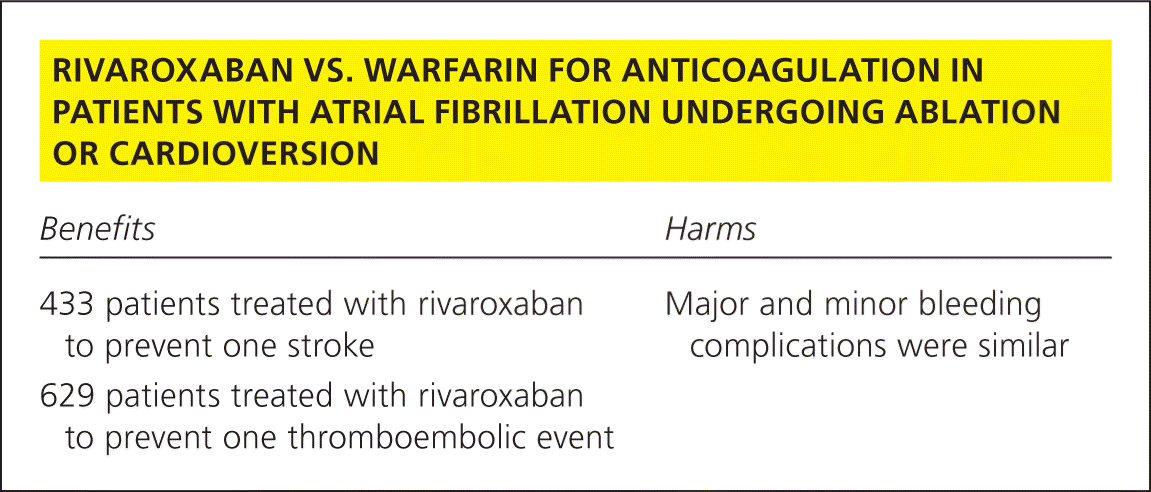
Am Fam Physician. 2016;94(7):online


| Benefits | Harms |
|---|---|
| 433 patients treated with rivaroxaban to prevent one stroke | Major and minor bleeding complications were similar |
| 629 patients treated with rivaroxaban to prevent one thromboembolic event |
Details for This Review
Study Population: Adults with atrial fibrillation undergoing a catheter ablation or cardioversion who received anticoagulation with rivaroxaban (Xarelto) or vitamin K antagonists (such as warfarin [Coumadin])
Efficacy End Points: Prevention of thromboembolism (stroke, transient ischemic attack, systemic embolism, or pulmonary embolism)
Harm End Points: Major and minor bleeding complications
Narrative: Atrial fibrillation is a common diagnosis (2.7 to 6.1 million adults in the United States1), which is typically treated with anticoagulation to prevent thromboembolism. In particular, patients undergoing catheter ablation or cardioversion are at an increased risk of complications (thromboembolism and bleeding) caused by the activation of the clotting cascade in addition to the invasive nature of the techniques used.2 The development of new anticoagulants over the past couple of years has raised questions about the optimal choice for treatment. Evaluating these new anticoagulants is complicated because the incidence of thromboembolism and bleeding is thought to be near or below 1%, requiring a large collection of data to effectively compare medications.3
A 2015 high-quality meta-analysis used data from 15 studies with a total of 8,872 patients undergoing catheter ablation or cardioversion and receiving rivaroxaban or a vitamin K antagonist. There were significantly fewer overall thromboembolic events (number needed to treat [NNT] = 629) and strokes (NNT = 433) in those receiving rivaroxaban compared with those receiving a vitamin K antagonist. Major and minor bleeding complications were noted to be statistically equivalent, occurring in 115 (4%) of those receiving rivaroxaban vs. 207 (4.9%) of those receiving a vitamin K antagonist (odds ratio = 0.84; 95% confidence interval, 0.66 to 1.08).3
Caveats: Despite a statistically significant advantage of rivaroxaban over vitamin K antagonists in the prevention of thromboembolism, further discussion is required to address the clinical significance of this finding given the relatively large NNT. With the incidence of major and minor bleeding complications being similar between the therapies, the concern for a higher complication rate with rivaroxaban because of a lack of a proven reversible agent is negligible. Cost is also a key factor when comparing these medications and was addressed in a recent study comparing rivaroxaban and vitamin K antagonistis for patients with nonvalvular atrial fibrillation. The study found that the higher cost of rivaroxaban is offset by the increased cost of initial hospitalization and long-term use of a vitamin K antagonist.4 Other considerations include diet restrictions, increased dosing complications, and the number of clinical visits for patients receiving a vitamin K antagonist. Considering these factors, rivaroxaban appears to be a reasonable alternative, despite a marginal NNT of 433 to prevent one stroke.
Although this study addressed the key adverse effects of major and minor bleeding disorders, it did not separate or clarify severity of the event, and in particular did not address death rate secondary to these complications.
This series is coordinated by Dean A. Seehusen, MD, MPH, AFP Contributing Editor, and Daniel Runde, MD, from the NNT Group (theNNT.com).
A collection of Medicine by the Numbers published in AFP is available at https://www.aafp.org/afp/mbtn.
This review is available from the NNT Group at http://www.thennt.com/nnt/rivaroxaban-vs-warfarin-anticoagulation-patients-atrial-fibrillation-undergoing-ablation-cardioversion/.
Author disclosure: No relevant financial affiliations.
